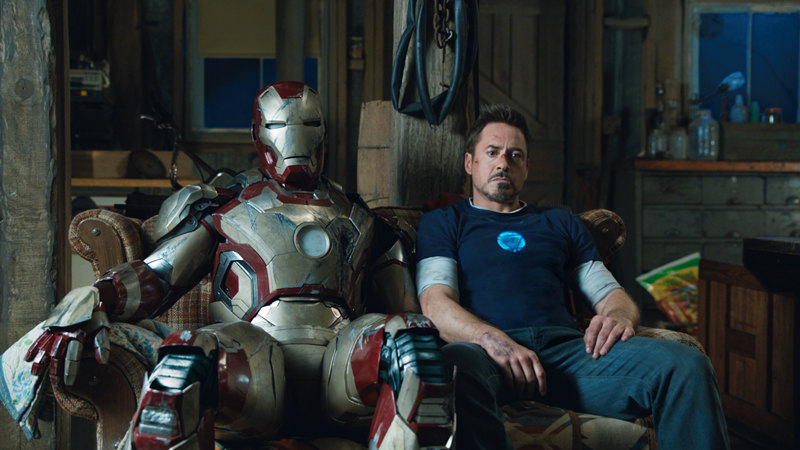If you really want to know how good a set “Star Trek: The Compendium” is, and whether or not it’s worth adding to your Blu-ray library, do what I did and show the two films to someone who has never seen them before. Then, base your decision on that person’s reaction. A data driven decision it isn’t, but my money is on you getting a positive reaction.
My wife, a self-proclaimed sci-fi know nothing, fell in love with these films after viewing 2009’s “Star Trek” with me one recent Friday night. I hadn’t seen the film from beginning to end since it first came out five years ago, and since her first film genre love is romantic comedies, I wasn’t all that optimistic. I think it took her about half the run time to really warm up, but she eagerly asked when we were going to watch “Star Trek Into Darkness” next. And, here’s the kicker: when that was over and done with, she asked when/if a third film was due in theaters.
With “Star Trek: The Compendium,” director J.J. Abrams’ phenomenal blockbusters arrive in the ultimate Blu-ray collector’s edition set. For the first time ever, these exhilarating films come together with a comprehensive array of insightful, new and existing bonus features for the definitive “Star Trek” experience. If you can think it about these modern reimaginings of the well-known series, it’s in this set. And if it isn’t in this set, well, you probably don’t need to worry about it.
Paramount is releasing “Star Trek: The Compendium” with four discs that dedicate one Blu-ray each to the films and one Blu-ray each to each film’s extras. Just in terms of numbers, it isn’t as robust an offering as, say, television series on DVD tend to be or other things of that nature. But this packaging is as good for the films as it is for the fans because it illustrates the careful continuity Abrams so desired. By my marks, he knocked it out of the park.
In “Star Trek,” things begin with James Kirk (Chris Pine) being born immediately following his father’s tragic death on the Federation starship USS Kelvin. A Romulan ship has lured the Kelvin to be a sitting duck, and despite saving his wife and young son, Kirk’s father dies on board. Several years later, we see the Vulcan, Spock (Zachary Quinto), join Starfleet rather than the Vulcan Science Academy. Their paths cross during Kirk’s training, which of course he didn’t come to naturally, but instead thanks to one Captain Pike (Bruce Greenwood), who saves him from getting his you know what kicked during a bar fight and prods him to enlist and become as good a man, perhaps better, as his father was.
After Kirk and Spock knock heads, their youthful colleagues are pulled into the primary response team when a distress signal from Vulcan is heard. Kirk and the cynical doctor, McCoy (Karl Urban), are assigned to Pike’s ship, the USS Enterprise. The ship arrives to find the same Romulan ship from years ago, the Narda, drilling into Vulcan’s core. Despite some help from Sulu (John Cho) during a space jump that disables the drill, Kirk cannot stop the Romulan ship from destroying Vulcan. When he confronts Spock regarding his decision making efforts and losing his mother during Vulcan’s implosion, we see where “Star Trek” is going to take us in an effort to deeply establish character positions en route to a joint effort to defeat the enemy.
“Star Trek” is so good you spend more time letting it take you along for a ride than you do trying to find connections between the earlier films, TV series and so forth. It is intentional in developing its lead players, knowing how critical they are to the film’s replay value and long term success. It falls in love with its visuals, but not to the point where it doesn’t seem to remember that they are but one layer to a successful motion picture. Its music is big, loud and so well placed throughout. We leave its just over two hour run time satisfied beyond our high expectations, and eager for more.
2013 brought “Star Trek Into Darkness,” which, appropriately so, is darker than the first film in many ways. The plot here requires slightly more attention from the movie going fan, but it also provides a worthwhile reward for this investment. Its pace is ambitious, and the sequel does run a few minutes longer than the original.
The film begins with Kirk being relieved of his command. Admiral Pike calls out his reckless behavior and leadership, separates him from Spock and deems him incapable of service. A Starfleet meeting is held after a London installation is bombed, but while Pike, Kirk and Spock are sorting out the culprit, he attacks. A Starfleet rebel named John Harrison (Benedict Cumberbatch) is the instigator, but he flees to Kronos, the Klingon planet.
A seek and destroy mission is hatched, with Kirk at the helm. After nearly getting his you know what handed to him by the Klingons, Kirk, Uhura (Zoe Saldana), Spock, McCoy and the rest of the crew secure Harrison on board the Enterprise. When he reveals himself to truly be a genetically-engineered superhuman named Khan, Harrison reveals his purpose is to seek vengeance on Fleet Admiral Alexander Marcus (Peter Weller…who I spent most of the film knowing I recognized but unsuccessfully able to identify). But Marcus denies Kahn’s claims, leaving Kirk and his crew stuck in the middle and perplexed as to who to believe.
“Star Trek Into Darkness” is a big film, and not just in terms of budget. It relies on several intersectional stories all developing simultaneously in order to work, and the viewing audience has to invest significantly for the film’s duration. What pleased me most was seeing how the Enterprise crew entrust their well-being with one another despite their obvious imperfections as mortals, so much so that they can argue and fight among themselves but not forget they are accountable for everyone on board. Yes, the plot on its surface is dedicated to figuring out Khan’s intentions and taking him down, but it’s also a chance for Kirk to come into his own and realize he is responsible for and accountable to others, not just himself.
Together, these current two reboots (a third is rumored to hit theaters in 2016) work hand-in-hand to build on one another. The continuity in characterization is extremely well done, more so than in most other series that successfully retain the performers from one film to the next. This said, “Star Trek: The Compendium” will be missing a title when 2016 rolls around, but hopefully by that time eager Trekkies, my wife among them, will have become so ravenous they dash to theaters like never before.
The human element is quite real during each film, and it lends authenticity to what, if you remove yourself for just a moment, can feel a little bit like you’re having to reach beyond your limits. But there’s no denying that many basic emotions pump their way through both titles, with everything from love to jealously to revenge to compassion to curiosity popping up now and again. Both “Star Trek” films really balance these emotions with action and pace very well, leaving me with a happy and healthy outlook on what’s to come for the new version. We don’t get drilled with action 24/7 and we don’t have to suffer through trenches of sludge from phony romantic whimpering all that much, either.
“Star Trek: The Compendium” successfully brings together sci-fi’s biggest releases from the last five years. If you don’t own it yet, you might start thinking about where to snag a copy.
Video:
Both titles land with 1080p 1.85:1 video transfers that blend human worlds and space together with great visual ease. Coloration here is ever so good, and clarity is top tier also. The cinematography, like the films, is very balanced with big, wide shots and close-ups, plus everything in between. We get to digest all the good stuff we can see with our own two eyes, and the editing during slower and faster points during each film fits the moment and plot happenings about as well as the musical selections. At day’s end, “Star Trek: The Compendium” puts out the best looking sci-fi in a decade.
Audio:
“Star Trek” comes with its English 5.1 Dolby TrueHD soundtrack that rattles your home theater with explosions, verbal spats, gunfire and shoes pounding on the squeaky bridge floors as crew members rush to navigate. “Star Trek Into Darkness” goes one further with an English 7.1 Dolby TrueHD option that barely one ups its younger sibling in multiple ways. Both titles feature fantastic musical scores that help to infuse the on screen adventure with raw emotional bliss. Each also offers French and Spanish Dolby Digital 5.1 options (a Portuguese Dolby Digital 5.1 choice is available with “Star Trek Into Darkness”), and both also provide English, French, Spanish and Portuguese subtitles.
Extras:
Simply too many to list, but you’ll get a digital copy of each film, gag reels, featurettes, stories that add depth to how the visuals were developed, interviews with the cast, audio commentaries, wardrobe, alien world creation, set design, art direction and, well, just about everything in between. Heck, there are so many extras to pick from, I could probably write a separate review of just them independent of the films.
A Final Word:
Extremely strong replay value and more or less engaging entertainment from beginning to end help these newer “Star Trek” titles amp up their game in multiple ways. This four-disc set is a wonderful way to bring good things together and make them, well, great.


